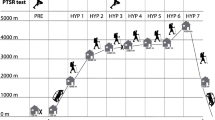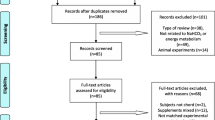Abstract
Purpose
This study determined the effects of pre-exercise sodium bicarbonate ingestion (ALK) on changes in oxygen uptake (\(\dot{V}O_{2}\)) at the end of a supramaximal exercise test (SXT).
Methods
Eleven well-trained cyclists completed a 70-s all-out cycling effort, in double-blind trials, after oral ingestion of either 0.3 g kg−1 of sodium bicarbonate (NaHCO3) or 0.2 g kg−1 body mass of calcium carbonate (PLA). Blood samples were taken to assess changes in acid–base balance before the start of the supramaximal exercise, and 0, 5 and 8 min after the exercise; ventilatory parameters were also measured at rest and during the SXT.
Results
At the end of the PLA trial, which induced mild acidosis (blood pH = 7.20), subjects presented a significant decrease in \(\dot{V}O_{2}\) (P < 0.05), which was related to the amplitude of the decrease in minute ventilation (\(\dot{V}_{E}\)) during the SXT (r = 0.70, P < 0.01, n = 11). Pre-exercise metabolic alkalosis significantly prevented the exercise-induced decrease in \(\dot{V}O_{2}\) in eleven well-trained participants (PLA: 12.5 ± 2.1 % and ALK: 4.9 ± 0.9 %, P < 0.05) and the decrease in mean power output was significantly less pronounced in ALK (P < 0.05). Changes in the \(\dot{V}O_{2}\) decrease between PLA and ALK trials were positively related to changes in the \(\dot{V}_{E}\) decrease (r = 0.74, P < 0.001), but not to changes in power output (P > 0.05).
Conclusions
Pre-exercise alkalosis counteracted the \(\dot{V}O_{2}\) decrease related to mild acidosis, potentially as a result of changes in \(\dot{V}_{E}\) and in muscle acid–base status during the all-out supramaximal exercise.




Similar content being viewed by others
Abbreviations
- ALK:
-
Alkalosis trial due to pre-exercise sodium bicarbonate ingestion
- BE:
-
Base excess
- Bf:
-
Breathing frequency
- CaCO3 :
-
Calcium carbonate
- FI:
-
Fatigue index
- H+ :
-
Proton
- HR:
-
Heart rate
- HRmax :
-
Maximal HR
- GXT:
-
Graded exercise test
- [HCO3 −]b :
-
Blood bicarbonate concentration
- [La]b :
-
Blood lactate concentration
- MAP:
-
Maximal aerobic power
- NaHCO3 :
-
Sodium bicarbonate
- Ptot:
-
Mean power for the entire test
- P20:
-
Mean power during the first 20 s of the test
- P50:
-
Mean power during the last 50 s of the test
- P5end :
-
Mean power during the last 5 s of the test
- pΔ50:
-
Power output midway between the MAP and the maximal theoretical power produced at the corresponding pedaling rate
- PETO2 :
-
End-tidal O2 tension
- PETCO2 :
-
End-tidal CO2 tension
- PLA:
-
Placebo trial due to pre-exercise calcium carbonate ingestion
- Pmax :
-
Maximal power output
- Post-Ing:
-
60 min post-ingestion of the supplementation or placebo
- Pre-Ex:
-
Immediately before the 70-s supramaximal exercise
- Post-Ex:
-
Immediately after the 70-s supramaximal exercise
- R5:
-
5 min of the recovery after the supramaximal exercise test
- R8:
-
8 min of the recovery after the supramaximal exercise test
- SaO2 :
-
Arterial oxygen saturation
- SXT:
-
Supramaximal exercise test
- \(\dot{V}CO_{2}\) :
-
Carbon dioxide production
- \(\dot{V}_{E}\) :
-
Minute ventilation
- \(\dot{V}O_{2}\) :
-
Oxygen uptake
- \(\dot{V}O_{2}\) max :
-
Maximal oxygen uptake
- \(\dot{V}O_{2}\) end :
-
Oxygen uptake at the end of the test in the last 5 s
- \(\dot{V}_{E}\) end :
-
Minute ventilation at the end of the test in the last 5 s
- \(\dot{V}O_{2}\) peak :
-
Peak oxygen uptake
- \(\dot{V}_{E}\) peak :
-
Peak minute ventilation
- V T :
-
Tidal volume
References
Astrand PO, Saltin B (1961) Maximal oxygen uptake and heart rate in various types of muscular activity. J Appl Physiol 16:977–981
Becker HM, Deitmer JW (2004) Voltage dependence of H + buffering mediated by sodium bicarbonate cotransport expressed in Xenopus oocytes. J Biol Chem 279:28057–28062
Berger NJ, McNaughton LR, Keatley S et al (2006) Sodium bicarbonate ingestion alters the slow but not the fast phase of VO2 kinetics. Med Sci Sports Exerc 38:1909–1917
Billat V, Hamard L, Koralsztein JP, Morton RH (2009) Differential modeling of anaerobic and aerobic metabolism in the 800-m and 1,500-m run. J Appl Physiol 107:478–487
Bishop D, Edge J, Davis C, Goodman C (2004) Induced metabolic alkalosis affects muscle metabolism and repeated-sprint ability. Med Sci Sports Exerc 36:807–813
Bohr C, Hasselbach K (1904) Krogh A Ueber einen in biologisher Beziehung wichtigen Einfluss, den die Kohlensaurespannung des Blutes auf dessen Sauerstoffbinding ueb. Skand Arch Physiol 16:1904
Dascombe BJ, Reaburn PR, Sirotic AC, Coutts AJ (2007) The reliability of the i-STAT clinical portable analyser. J Sci Med Sport 10:135–140
Dorel S, Couturier A, Lacour J-R et al (2010) Force-velocity relationship in cycling revisited: benefit of two-dimensional pedal forces analysis. Med Sci Sports Exerc 42:1174–1183
Duffin J (2005) Modelling the respiratory chemoreflex control of Acid-base balance. Conf Proc IEEE Eng Med Biol Soc 6:5836–5839
Fitts RH (1996) Muscle fatigue: the cellular aspects. Am J Sports Med 24:S9–S13
Forbes SC, Raymer GH, Kowalchuk JM, Marsh GD (2005) NaHCO3-induced alkalosis reduces the phosphocreatine slow component during heavy-intensity forearm exercise. J Appl Physiol 99:1668–1675
Forster HV, Pan LG (1995) Contribution of acid-base changes to control of breathing during exercise. Can J Appl Physiol 20:380–394
Gaitanos GC, Williams C, Boobis LH, Brooks S (1993) Human muscle metabolism during intermittent maximal exercise. J Appl Physiol 75:712–719
González-Alonso J, Calbet JAL (2003) Reductions in systemic and skeletal muscle blood flow and oxygen delivery limit maximal aerobic capacity in humans. Circulation 107:824–830
Hanon C, Leveque JM, Thomas C et al (2008) Pacing strategy and VO2 kinetics during a 1500-m race. Int J Sports Med 29:206–211
Hanon C, Thomas C (2011) Effects of optimal pacing strategies for 400-, 800- and 1500-m races on the VO2 response. J Sports Sci 29(9):905–912. doi:10.1080/02640414.2011.562232
Hanon C, Lepretre PM, Bishop D, Thomas C (2010) Oxygen uptake and blood metabolic responses to a 400-m run. Eur J Appl Physiol 109:233–240
Hanon C, Dorel S, Delfour-Pereython R et al (2013) Prevalence of cardio-respiratory factors in the occurrence of the decrease in oxygen uptake during supra-maximal, constant-power exercise. SpringerPlus 2:651
Harms CA, McClaran SR, Nickele GA et al (2000) Effect of exercise-induced arterial O2 desaturation on VO2max in women. Med Sci Sports Exerc 32:1101–1108
Higgins MF, James RS, Price MJ (2013) The effects of sodium bicarbonate (NaHCO(3)) ingestion on high intensity cycling capacity. J Sports Sci 31:972–981
Hirvonen J, Nummela A, Rusko H et al (1992) Fatigue and changes of ATP, creatine phosphate, and lactate during the 400-m sprint. Can J Sport Sci 17:141–144
Hollidge-Horvat MG, Parolin ML, Wong D et al (2000) Effect of induced metabolic alkalosis on human skeletal muscle metabolism during exercise. Am J Physiol Endocrinol Metab 278:E316–E329
Howley ET, Bassett DR Jr, Welch HG (1995) Criteria for maximal oxygen uptake: review and commentary. Med Sci Sports Exerc 27:1292–1301
Jalab C, Enea C, Delpech N, Bernard O (2011) Dynamics of oxygen uptake during a 100 m front crawl event, performed during competition. Appl Physiol Nutr Metab 36:219–225. doi:10.1139/h10-107
Jones AM, Wilkerson DP, Vanhatalo A, Burnley M (2008) Influence of pacing strategy on O2 uptake and exercise tolerance. Scand J Med Sci Sports 18:615–626
Jubrias SA, Crowther GJ, Shankland EG et al (2003) Acidosis inhibits oxidative phosphorylation in contracting human skeletal muscle in vivo. J Physiol (Lond) 553:589–599
Kolkhorst FW, Rezende RS, Levy SS, Buono MJ (2004) Effects of sodium bicarbonate on VO2 kinetics during heavy exercise. Med Sci Sports Exerc 36:1895–1899
Kristensen JM, Kristensen M, Juel C (2004) Expression of Na +/HCO3- co-transporter proteins (NBCs) in rat and human skeletal muscle. Acta Physiol Scand 182:69–76
Lindinger MI, Heigenhauser GJF (2012) Effects of gas exchange on acid-base balance. Compr Physiol 2:2203–2254
Miyachi M, Katayama K (1999) Effects of maximal interval training on arterial oxygen desaturation and ventilation during heavy exercise. Jpn J Physiol 49:401–407
Mortensen SP, Damsgaard R, Dawson EA et al (2008) Restrictions in systemic and locomotor skeletal muscle perfusion, oxygen supply and VO2 during high-intensity whole-body exercise in humans. J Physiol (Lond) 586:2621–2635. doi:10.1113/jphysiol.2007.149401
Nielsen HB (1999) pH after competitive rowing: the lower physiological range? Acta Physiol Scand 165:113–114
Nielsen HB, Bredmose PP, Stromstad M et al (2002) Bicarbonate attenuates arterial desaturation during maximal exercise in humans. J Appl Physiol 93:724–731
Nummela A, Vuorimaa T, Rusko H (1992) Changes in force production, blood lactate and EMG activity in the 400-m sprint. J Sports Sci 10:217–228
Peronnet F, Aguilaniu B (2006) Lactic acid buffering, nonmetabolic CO2 and exercise hyperventilation: a critical reappraisal. Respir Physiol Neurobiol 150:4–18
Perrey S, Candau R, Millet GY et al (2002) Decrease in oxygen uptake at the end of a high-intensity submaximal running in humans. Int J Sport Med 23:298–304
Saunders B, Sale C, Harris RC, Sunderland C (2013) Sodium bicarbonate and high-intensity cycling capacity: variability in responses. Int J Sports Physiol Performance 9:627–632
Stephens TJ, McKenna MJ, Canny BJ et al (2002) Effect of sodium bicarbonate on muscle metabolism during intense endurance cycling. Med Sci Sports Exerc 34:614–621
Street D, Nielsen JJ, Bangsbo J, Juel C (2005) Metabolic alkalosis reduces exercise-induced acidosis and potassium accumulation in human skeletal muscle interstitium. J Physiol 566:481–489
Thomas C, Hanon C, Perrey S et al (2005) Oxygen uptake response to an 800-m running race. Int J Sports Med 26:268–273
Walsh B, Tiivel T, Tonkonogi M, Sahlin K (2002) Increased concentrations of P(i) and lactic acid reduce creatine-stimulated respiration in muscle fibers. J Appl Physiol 92:2273–2276
Zoladz JA, Szkutnik Z, Duda K et al (2005) Preexercise metabolic alkalosis induced via bicarbonate ingestion accelerates Vo2 kinetics at the onset of a high-power-output exercise in humans. J Appl Physiol 98:895–904
Acknowledgments
The authors thank the athletes for their time and efforts, and are grateful to the French Ministry of Health, Youth and Sport for their financial support. They also thank Doctor Christian Palierne for his medical assistance, and Pierrick Arnal, Julien Siracusa, and Thibault Herluison for their technical assistance. The authors are grateful to the French Ministry of Health, Youth and Sport for their financial support (Grant 11-i-40).
Author information
Authors and Affiliations
Corresponding author
Ethics declarations
Conflict of interest
The authors declare no conflicts of interest, financial or otherwise.
Additional information
Communicated by Carsten Lundby.
Rights and permissions
About this article
Cite this article
Thomas, C., Delfour-Peyrethon, R., Bishop, D.J. et al. Effects of pre-exercise alkalosis on the decrease in \(\dot{V}O_{2}\) at the end of all-out exercise. Eur J Appl Physiol 116, 85–95 (2016). https://doi.org/10.1007/s00421-015-3239-0
Received:
Accepted:
Published:
Issue Date:
DOI: https://doi.org/10.1007/s00421-015-3239-0




